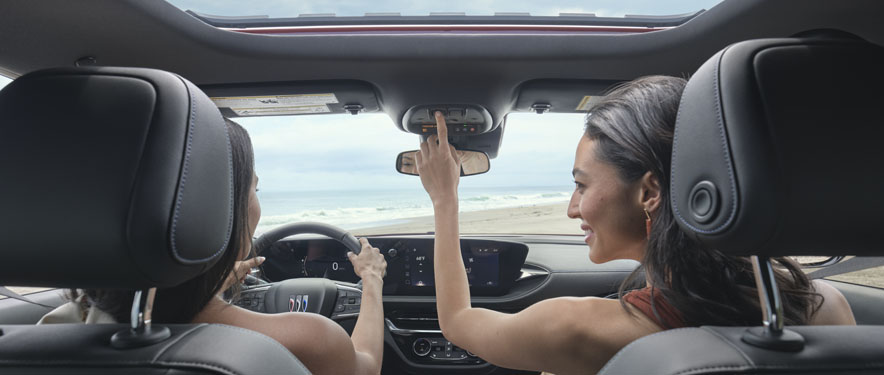- Home
- Financial Resources
- Financial Articles
- Turn Your Camping Dreams into Reality

Turn Your Camping Dreams into Reality
By Scooter Hendon / 06/17/2020 / Your Lifestyle
The warmth of the sunshine. The smell of pine trees. The sound of a lazy river. Your dreams of packing up your vehicle and heading outdoors to experience nature are so close you can almost see them. But where should you choose to experience all this?
Due to COVID-19, the idea of road trips, camping and wide-open spaces is more popular than ever. Remember to take precautions to stay safe and practice social distancing when appropriate.
Narrowing down the perfect place to load into your navigation system can be harder than you think. Below, you’ll discover where to find different places and tips on how to select the campsite that's right for you when you want to hit the trail, pitch a tent or just experience the open air.
Where to Find Campsites
State Parks
Every state has a park system, and these facilities can provide a wealth of activities and natural beauty. Depending on the location, you might find:
- Campsites with or without water and electricity
- Screened-in shelters or cabins
- Lakes, ponds or rivers for fishing, canoeing and/or swimming
- All-access annual passes, which can ultimately save you money
Check your state’s park system website for details and updates on their COVID-19 protocol.
National Parks
When many people think of “National Parks,” they think of places like Yellowstone or Yosemite. Those parks are iconic, but many people don’t know that the national system of parks numbers upward of 60,000 locations. The National Park Service, U.S. Army Corps of Engineers, Bureau of Land Management and others offer a broad variety of activities. As with state parks, many national parks also have annual passes that can be a good option if you’re a frequent visitor. Visit recreation.gov and let the discovery begin.
Independent Parks
Independent parks abound, but they can vary in accommodation, quality and consistency. Visit websites like US Park Advisor and other review-based sites to see the wealth of options available. Many of these sites also have smartphone apps and feature reviews and ratings so you can better manage your expectations.
National Chains
Some park chains around the country can offer consistent experiences that make it easy to know what you’re getting into. Companies like KOA Campgrounds and Jellystone Parks have locations all over the nation and make it easy to reserve and plan.
Camping Tips to Remember
Budget and organize
Although loading up your vehicle to go camping can be a less expensive than some other kinds of travel, you might be surprised how quickly costs can add up. Make a list of everything you need to bring as well as how much money you might spend on things like:
- Fuel and vehicle maintenance expenses
- Meals for on the road and at the campsite
- Essentials like a flashlight, knife, rope, tent or sleeping bag
- Entrance and camping fees for the park
- Activities specific to your destination, like canoe rental or fishing license and equipment
- Souvenirs
Plan ahead
If a park looks like a great place to visit, chances are that others have also taken notice. Many campgrounds have online reservation systems, and some will allow you to book individual sites. The busiest times accompany the nicest weather, so booking months in advance for the spring and fall might be a necessity in some parks. You never want to show up to an overbooked park and have to scramble for an alternative plan.
With the pandemic in mind, you’ll want to be even more cautious in your preparation. If you choose to do a road trip, bring hand sanitizer and masks for each person in your quarantine crew, and check ahead of time for what’s open and what the safety precautions are.
Fire it up
For some, a campfire is as crucial to the campsite as a sleeping bag and a flashlight. But, depending on where you go, there could be a burn ban in effect and your dreams of s’mores and fireside ghost stories could go up in smoke before they even begin. Do your best to stay safe and within the law with these tips:
- Check the state forestry service website to see what counties or other areas might not allow ground fires at the time.
- Call ahead or check your destination’s website to see if gathering firewood is allowed.
- If ground fires aren’t permitted, make sure self-contained propane fires are OK so you can cook on a camp stove or use a propane heater to stay warm.
Tents aren’t the only option
You might think that a sleeping bag and a tent might be your only choice for camping, but many parks have cabins and covered shelters that you can reserve. Hammock camping can also be a comfortable alternative to explore. Check with the park beforehand if a hammock sounds enticing, as some parks have regulations against attaching to trees.
Location, location, location
If all these options are intimidating, pick a body of water that looks attractive and search for campsites around it. It’s hard to find a river or lake without several parks surrounding it, so choosing one can help narrow your search.
Experiencing the outdoors can be a fun way to relax, and being ready for your adventure is the best way to enjoy your time to the fullest. For other ways to prepare, read our tips on planning for the ultimate camping trip and how to identify your road trip personality.
By Scooter Hendon, GM Financial
Scooter Hendon might work indoors, but his heart is in the outdoors. Whether he's with his family or flying solo, he loves a good camping, backpacking or hiking adventure. When Scooter’s not hitting the road in his Chevy Silverado to a state or national park, he’s saving up for his next trip.
Related Articles

Ace Your Spring Break Road Trip
Whether you’re looking to take a day trip or embark on the adventure of a lifetime, these tips will help make your spring break road trip safe, fun and unforgettable.
PACK UP, HEAD OUT
GM Vehicles Take the Field
Take a second to imagine what position your GM vehicle might play if it was on your favorite football team.
TOUCHDOWN